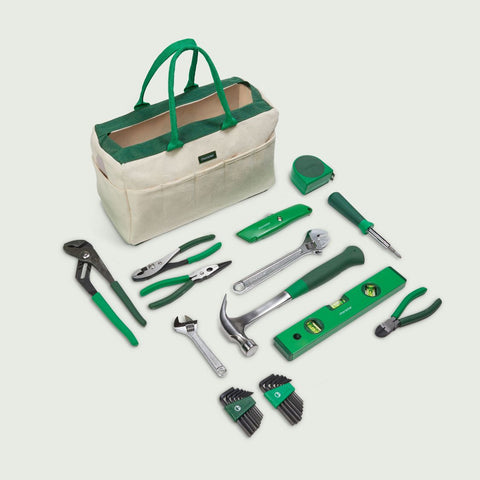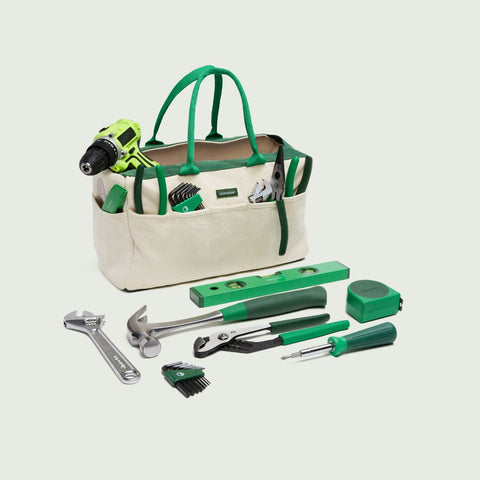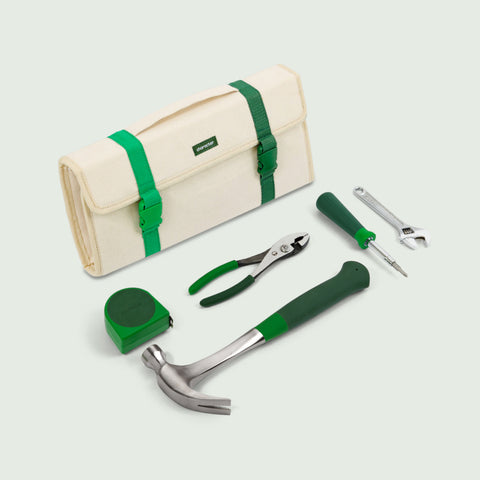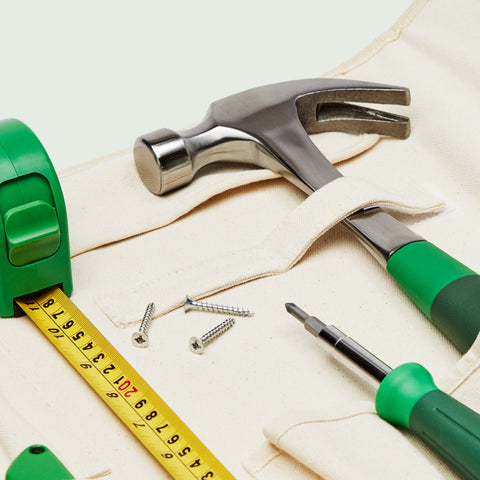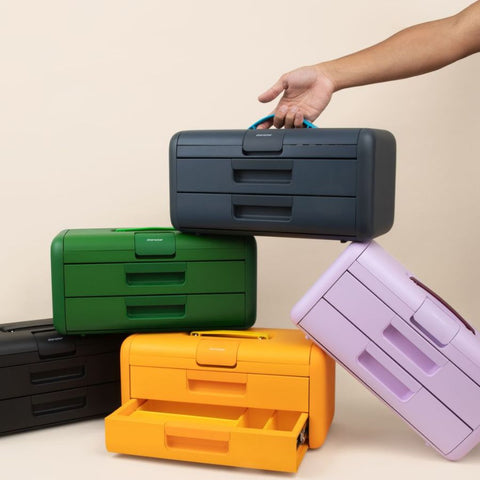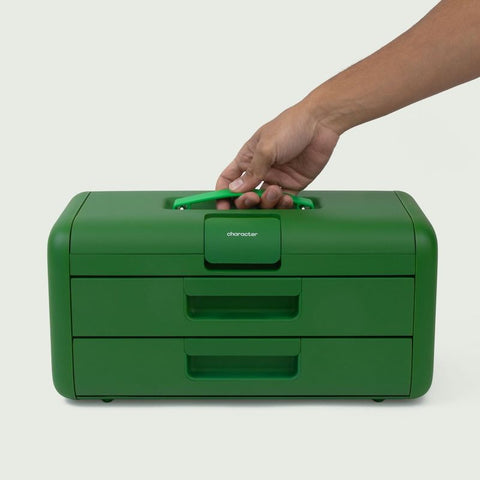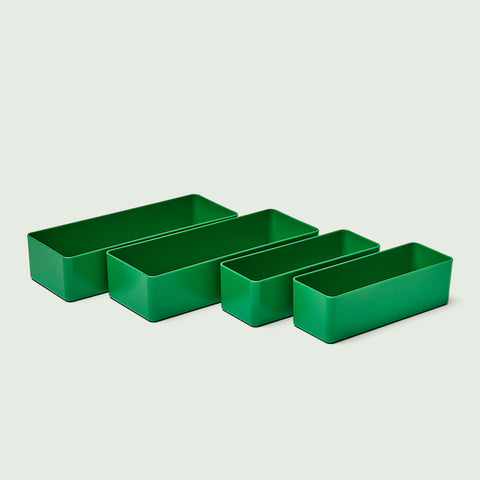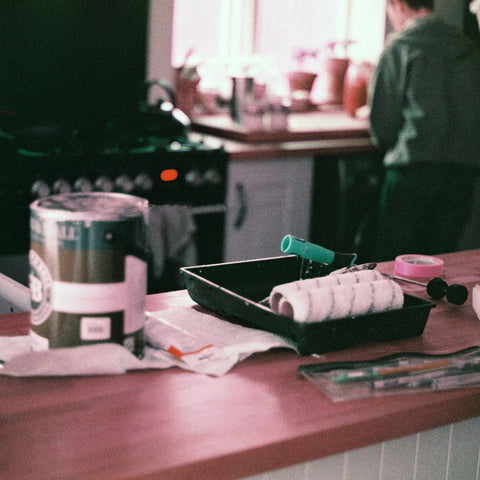
If you’re looking for a relatively simple and inexpensive way to level up any room in your house, allow me to introduce you to wall moldings. This category of home DIY projects is vast and the possibilities are truly endless when it comes to making your space feel more custom, more high end, more fun, and more unique. From traditional wainscotting to funky accent walls, you can build three-dimensional art on your walls with just some wood, a nail gun, and some paint. If you’re not sure where to begin, let this guide serve as your inspiration and step-by-step guide. If you need extra help, text our experts to run any ideas or questions by a professional set of eyes.
There are so many types of wall moldings you can add to your home, but in this blog, we’re going to cover just a handful:
Chair or picture rail
Wainscotting
Board and batten
Picture frame molding (or box molding)

Chair or Picture Rail
Probably the simpliest molding option is a chair rail or a picture rail. A chair rail was originally adding for protecting walls from chair backs, but is now often used for visual interest. It goes about hprizontaly around the room, typically about 32–36 inches from the floor. It’s just one piece of trim to install, however, is usually paired with wainscotting or paint. Similarly, a picture rail is one single piece of trim, however, higher on the — decorative way to hang art without putting holes in the wall. It was popular in older homes or vintage-inspired spaces, but can also be used with paint and wainscotting.
Wainscotting
 Usually paired with a chair or picture rail, wainscotting adds texture and depth to any space and involves covering the bottom half of a wall with some paneling. It’s great for entryways, dining rooms, and bathrooms, but can be used anywhere. Choose from beadboard, shiplap, raised panel, or flat panels.
Usually paired with a chair or picture rail, wainscotting adds texture and depth to any space and involves covering the bottom half of a wall with some paneling. It’s great for entryways, dining rooms, and bathrooms, but can be used anywhere. Choose from beadboard, shiplap, raised panel, or flat panels.
Board & Batten
 Board and batten is a type of wall treatment that adds depth, texture, and a bit of rustic or classic charm to a room. It's made by installing wide boards (or panels) vertically on a wall, then covering the seams or spaces between them with narrower strips of wood called battens. However, if you plan to paint the panels, many people skip adding the boards and just use the drywall, accented by narrower stripes of wood.
Board and batten is a type of wall treatment that adds depth, texture, and a bit of rustic or classic charm to a room. It's made by installing wide boards (or panels) vertically on a wall, then covering the seams or spaces between them with narrower strips of wood called battens. However, if you plan to paint the panels, many people skip adding the boards and just use the drywall, accented by narrower stripes of wood.
What you’ll need:
Wood or MDF
Level or triangle
Nail gun
Caulk
Wood filler
Paint
How to install board & batten
With all of these wall molding projects, there’s lots of room for customization… and math. Utilizing a board and batten calculator can eliminate some of the headache. Start by measuring your space and determining how many battens you want, and how far apart you want them to be space. Once you’ve figured out your layout, you’re ready to begin.
Remedy your trim situation
Your wall will probably have baseboards on it already. You can either remove these and add your own to match the new board and batten, or you can add a piece of cove trim to the top of your baseboards to give your new boards a flat surface to match up with.
Measure and mark
Go along your wall and mark where your vertical boards will go. This will save you time once you get started.
Cut your wood peices
Next, cut your vertical boards to length.
Attach your vertical battens
Using the measurements you took before, line your cut wood up and attach it to the wall with your nail gun. Use a level or triangle to ensure that your boards are at exact 90-degree angles and straight.
Attach your horizonal battens
To finish the design, you’ll want to top off your vertical boards with one long horizontal boards. You may want to add additional molding above the horizontal board for visual interest.
Caulk + wood fill
To prepare for paint, fill all the nail holes with wood filler and caulk all of the seams, where two boards meet or a board meets drywall.
Paint
Finally paint the entire thing to transform your space.
Picture Frame Molding
If you’re looking to add a subtle, yet elegant accent to your space, picture frame molding is a popular choice. It includes adding box shapes on the wall, usually between the baseboard and chair rail or all the way up the wall. It creates a formal, classic look.
What you’ll need:
Trim of your choice (wood, mdf, or pvc)
Level or triangle
Wood glue or construction adhesive
Nail gun
Caulk
Wood filler
Paint
Miter saw or shears
How to install picture frame molding
 You can customize how large your want the boxes to be on the wall, as well as how many you want, and how far up the wall they go. If you plan to hang a mirror or install shelves, it’s easiest to hang those first and then plan your boxes around them. A good tip is to lay out the boxes how you think you’ll want them in painter’s tape to visualize the design.
You can customize how large your want the boxes to be on the wall, as well as how many you want, and how far up the wall they go. If you plan to hang a mirror or install shelves, it’s easiest to hang those first and then plan your boxes around them. A good tip is to lay out the boxes how you think you’ll want them in painter’s tape to visualize the design.
Which trim to select
You can pick from a variety of trim styles and materials. Wood is the most durable, however it’s also the most expensive. If you plan to stain the boxes, you’ll have to choose wood, but will have to be careful about humidity — which can cause the wood to warp. Another option is MDF, which is budget-friendly and ready for paint. It’s not moisture-resistant, however, it’s very easy to cut. Lastly, PVC is a great option for uneven walls, thanks to their flexibilty and forgiving shape. They won’t rot or warp with humidity or water, but can be more expensive than even wood.
How to install picture frame molding
After you’ve measured your space and planned out your design, you’re ready to begin.
Cut your trim and miter the corners
When you cut your trim to length, be sure to consider how you’ll miter the edges. Mitering means to cut them at a 45-degree angle. You can use a miter saw or miter shears to do this. Cut the edges of the trim so that when the corners line up, they make a complete box.
Attach trim to the wall
Using a nail gun, attach the individual piece of trim to the wall.
Connect the box
At the corners, use wood glue or constructive adhesive to connect the mitered edges. You’ll want to go back and fill any gaps with wood filler.
Prep for paint
In addition to filling gaps at the corner, fill your nail holes and caulk all the seams.
Paint
Now you can paint the wall and the trim to make them look seamless. Paint everything the same color for a monochromic look or paint the boxes and the wall inside them as an accent to the rest of the wall.

Wall moldings are a great beginner-friendly DIY that can transform an entire room or wall. With minimal time and tools, you’ll be able to add character and definition to otherwise standard walls. Whatever molding you choose, there is so much room for customization. You’ll be able to make a truly unique space with just a little bit of creativity.
